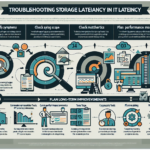Configuring LUN masking and zoning on a Storage Area Network (SAN) is essential for securing and optimizing storage access in your IT infrastructure. Below are the steps to configure LUN masking and zoning effectively:
1. Prerequisites
- Ensure you have administrative access to your SAN fabric (via the SAN switch management interface) and storage array management tools.
- Confirm you have a clear understanding of the Host Bus Adapter (HBA) World Wide Names (WWNs) or iSCSI Qualified Names (IQNs) for the servers that need access to the storage.
- Identify the LUNs and determine which servers require access to them.
2. Zoning on SAN Switch
Zoning controls which devices can communicate with each other on the SAN fabric. It is configured on the SAN switches.
Steps to Configure Zoning:
- Log in to the SAN switch management interface:
-
Use a web interface, CLI (Command Line Interface), or GUI provided by the switch vendor (e.g., Brocade, Cisco MDS).
-
Create a Zone:
- Create a new zone in the zoning configuration.
- Assign the WWNs or port identifiers of the storage array (target) and the server’s HBA (initiator) to the zone.
Example (CLI for Brocade):
zonecreate "ZoneName", "WWN1;WWN2"
- Add the Zone to a Zone Set:
- A zone set is a collection of zones that are activated together.
- Add the new zone to the active zone set.
Example (CLI for Brocade):
zonesetadd "ZoneSetName", "ZoneName"
- Activate the Zone Set:
- Activate the updated zone set to apply the changes to the SAN fabric.
Example (CLI for Brocade):
zonesetactivate "ZoneSetName"
- Verify Zoning:
- Check the zoning configuration to ensure the changes are active.
Example (CLI for Brocade):
cfgshow
3. LUN Masking on Storage Array
LUN masking ensures that only specific servers can access particular LUNs on the storage array.
Steps to Configure LUN Masking:
- Log in to the Storage Array Management Interface:
-
Use the vendor-specific tool or web interface (e.g., Dell EMC Unisphere, NetApp ONTAP, HPE Nimble, etc.).
-
Identify the LUNs and Initiators:
- Locate the LUNs you want to mask.
-
Identify the WWN or IQN of the server’s HBA.
-
Create a Storage Group (Optional):
-
Some storage arrays require you to group LUNs together into a storage group for easier management.
-
Map LUNs to Host (Initiator):
- Using the management interface, associate the LUNs with the specific initiator (server’s HBA).
-
This step ensures only the specified server can see and access the LUN.
-
Set Access Permissions:
-
Configure the access permissions for the LUNs, specifying read/write or read-only access, depending on your requirements.
-
Apply Changes:
-
Save the configuration and apply the changes.
-
Verify Connectivity:
- On the server, rescan the HBA or iSCSI initiator to confirm it can see the assigned LUNs.
4. Test and Validate
- On the Server: Rescan the HBA or iSCSI initiator and verify that the correct LUNs are visible.
- On the SAN: Verify that zoning is functioning correctly by checking SAN fabric connectivity.
- On the Storage Array: Ensure that LUN masking is restricting access as expected.
5. Best Practices
- Use single-initiator zoning (one initiator and one target per zone) to simplify troubleshooting and enhance security.
- Keep a record of all configurations, including WWNs, zones, and LUN mappings, for documentation and auditing purposes.
- Regularly monitor your SAN fabric and storage array for unauthorized access or performance issues.
- Use redundant paths and multipathing software (e.g., VMware Native Multipathing, Microsoft MPIO) to ensure availability and fault tolerance.
By following these steps, you can ensure secure and optimized access to storage resources in your SAN environment. Let me know if you need further assistance with any specific vendor or tool!



